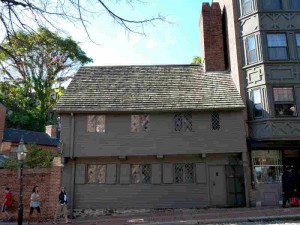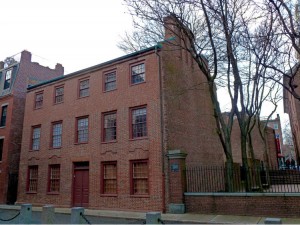Select your language to auto-translate:
Oldest Building in Boston c. 1680
This was home to the Revere family at the time of Paul’s famous ride to alert the Patriots of the British march on Lexington and Concord.
Admission.
Open year round. Check here for rates and times:
https://www.paulreverehouse.org/hours-prices/
(617) 523-2338
Handicap accessible first floor (about 1/2 of the small museum). Ask at the ticket booth for a temporary ramp.
No restrooms
Public transportation: Green or Orange line to Haymarket Station.
Interesting old house with knowledgeable guides, the last of its type in Boston. Some Revere relics. It is very small. Photography inside prohibited.
Plan 1/4-1/2 hour.
Background Information
The Paul Revere House in North Square is the oldest remaining building in Boston. It was built on the ashes of the Second Church of Boston’s (Old North Meeting House) parsonage, which was the home to Increase Mather and his family (including his son Cotton). The parsonage burned in 1676.
The original house dates from about 1680. Its first owner was Robert Howard. By the time Revere purchased the house in 1770 it had undergone significant changes with the front roof line being raised in the popular Georgian style and a partial third story added.
Revere moved in with his first wife, Sarah, his mother and five of his children. Sarah bore him a total of eight children, and he had another eight with his second wife, Rachel. Revere’s silversmith shop was a couple of blocks away.
Revere owned the house until 1800, but likely moved out as early as 1780. After he sold the house, it served as a tenement with its ground floor remodeled for use as shops.
The house was purchased by Revere’s great-grandson in 1902 to prevent its demolition. It then underwent restoration to an approximation of its 1700 appearance, opening in 1908 as one of the earliest historic house museums in the United States.
During the renovation, the roof line was restored to its original pitch, but without its gable. Despite the renovation, ninety percent of the house is original including the foundation and inner wall material, some doors, window frames, and portions of the flooring, foundation, inner wall material and raftering. All the glass has been replaced. Inside, there are several pieces of furniture believed to have belonged to the Reveres.
Adjacent to the Paul Revere house is the brick Pierce-Hichborn House, built about 1711 in the Georgian style. It was owned by Nathaniel Hichborn, a boat builder and cousin of Revere’s. It is also a nonprofit museum operated by the Paul Revere Memorial Association.
North Square, North Meeting House & Garden Court Street
The North Square is directly across the street from the Paul Revere house. It was the center of the North End life and commerce during Colonial times and the site of some of the town’s most impressive mansions.
It was also the site for the North Meeting House (Boston’s Second Church), which was first built in 1649, burned down in 1673, and rebuilt the following year. It was used by the British for firewood during the winter of 1775-76 during the Siege of Boston.
Just around the corner from North Square is Garden Court Street. This was the site of the Clark-Frankland and Thomas Hutchinson mansions. Rose Fitzgerald (Kennedy), the mother of President John F. Kennedy, was born at 2 Garden Court Street in 1890.
St. Stephen’s, Paul Revere Mall & Clough House
The Freedom Trail from Paul Revere’s house takes a left down Prince Streetand a right hand turn on Hanover Street. Proceeding down Hanover Street, just before you cross to enter the Paul Revere Mall, you will pass St. Stephen’s Church.
Saint Stephen’s is the last remaining Charles Bulfinch designed church in Boston. It was completed in 1804 as the New North Congregational Church. It became Unitarian in 1813, and in 1862 was sold to the Roman Catholic Diocese of Boston and renamed St. Stephen’s.
Crossing Hanover Street, you enter the Paul Revere Mall. The iconic statue you encounter (also on the cover of the Guide and at the start of the North End chapter) is by Cyrus Dallin. Dallin was a famous sculptor that worked in the nearby town of Arlington, MA. For my blog entry on the Dallin Museum, click here.
The Paul Revere Mall, also known as The Prado by locals, was created in 1933. It is a brick passage and park that leads from Hanover Street to the Old North Church. The mall walls are lined with bronze plaques that commemorate famous North End residents.
Clough House
At the end of the Mall, just before the stairs up to the Old North Church, is the Clough House, which dates from 1712. One of the oldest homes remaining in Boston, it was home to Ebenezer Clough, a master mason who helped build Old North Church. This is representative of many houses that once made up this neighborhood. It also houses an small but excellent historic printing museum, The Printing Office of Edes & Gil, website here. Check to see if it open.

























[…] Stop 12 – Paul Revere House. Built in 1680, it is the oldest structure remaining in Boston. It is a good example of a period dwelling and you will gain insights into Paul Revere’s life. The costumed docents provide interesting descriptions of the house and the Revere family. Visiting is worthwhile, but the house is small, consisting of only four rooms. Plan for about 1/2 hour. […]